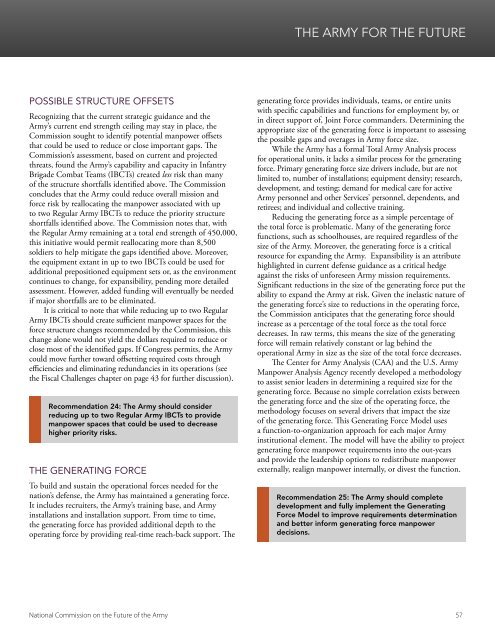THE FUTURE OF THE ARMY
Futurearmy
Futurearmy
You also want an ePaper? Increase the reach of your titles
YUMPU automatically turns print PDFs into web optimized ePapers that Google loves.
<strong>THE</strong> <strong>ARMY</strong> FOR <strong>THE</strong> <strong>FUTURE</strong><br />
POSSIBLE STRUCTURE <strong>OF</strong>FSETS<br />
Recognizing that the current strategic guidance and the<br />
Army’s current end strength ceiling may stay in place, the<br />
Commission sought to identify potential manpower offsets<br />
that could be used to reduce or close important gaps. The<br />
Commission’s assessment, based on current and projected<br />
threats, found the Army’s capability and capacity in Infantry<br />
Brigade Combat Teams (IBCTs) created less risk than many<br />
of the structure shortfalls identified above. The Commission<br />
concludes that the Army could reduce overall mission and<br />
force risk by reallocating the manpower associated with up<br />
to two Regular Army IBCTs to reduce the priority structure<br />
shortfalls identified above. The Commission notes that, with<br />
the Regular Army remaining at a total end strength of 450,000,<br />
this initiative would permit reallocating more than 8,500<br />
soldiers to help mitigate the gaps identified above. Moreover,<br />
the equipment extant in up to two IBCTs could be used for<br />
additional prepositioned equipment sets or, as the environment<br />
continues to change, for expansibility, pending more detailed<br />
assessment. However, added funding will eventually be needed<br />
if major shortfalls are to be eliminated.<br />
It is critical to note that while reducing up to two Regular<br />
Army IBCTs should create sufficient manpower spaces for the<br />
force structure changes recommended by the Commission, this<br />
change alone would not yield the dollars required to reduce or<br />
close most of the identified gaps. If Congress permits, the Army<br />
could move further toward offsetting required costs through<br />
efficiencies and eliminating redundancies in its operations (see<br />
the Fiscal Challenges chapter on page 43 for further discussion).<br />
Recommendation 24: The Army should consider<br />
reducing up to two Regular Army IBCTs to provide<br />
manpower spaces that could be used to decrease<br />
higher priority risks.<br />
<strong>THE</strong> GENERATING FORCE<br />
To build and sustain the operational forces needed for the<br />
nation’s defense, the Army has maintained a generating force.<br />
It includes recruiters, the Army’s training base, and Army<br />
installations and installation support. From time to time,<br />
the generating force has provided additional depth to the<br />
operating force by providing real-time reach-back support. The<br />
generating force provides individuals, teams, or entire units<br />
with specific capabilities and functions for employment by, or<br />
in direct support of, Joint Force commanders. Determining the<br />
appropriate size of the generating force is important to assessing<br />
the possible gaps and overages in Army force size.<br />
While the Army has a formal Total Army Analysis process<br />
for operational units, it lacks a similar process for the generating<br />
force. Primary generating force size drivers include, but are not<br />
limited to, number of installations; equipment density; research,<br />
development, and testing; demand for medical care for active<br />
Army personnel and other Services’ personnel, dependents, and<br />
retirees; and individual and collective training.<br />
Reducing the generating force as a simple percentage of<br />
the total force is problematic. Many of the generating force<br />
functions, such as schoolhouses, are required regardless of the<br />
size of the Army. Moreover, the generating force is a critical<br />
resource for expanding the Army. Expansibility is an attribute<br />
highlighted in current defense guidance as a critical hedge<br />
against the risks of unforeseen Army mission requirements.<br />
Significant reductions in the size of the generating force put the<br />
ability to expand the Army at risk. Given the inelastic nature of<br />
the generating force’s size to reductions in the operating force,<br />
the Commission anticipates that the generating force should<br />
increase as a percentage of the total force as the total force<br />
decreases. In raw terms, this means the size of the generating<br />
force will remain relatively constant or lag behind the<br />
operational Army in size as the size of the total force decreases.<br />
The Center for Army Analysis (CAA) and the U.S. Army<br />
Manpower Analysis Agency recently developed a methodology<br />
to assist senior leaders in determining a required size for the<br />
generating force. Because no simple correlation exists between<br />
the generating force and the size of the operating force, the<br />
methodology focuses on several drivers that impact the size<br />
of the generating force. This Generating Force Model uses<br />
a function-to-organization approach for each major Army<br />
institutional element. The model will have the ability to project<br />
generating force manpower requirements into the out-years<br />
and provide the leadership options to redistribute manpower<br />
externally, realign manpower internally, or divest the function.<br />
Recommendation 25: The Army should complete<br />
development and fully implement the Generating<br />
Force Model to improve requirements determination<br />
and better inform generating force manpower<br />
decisions.<br />
National Commission on the Future of the Army 57


